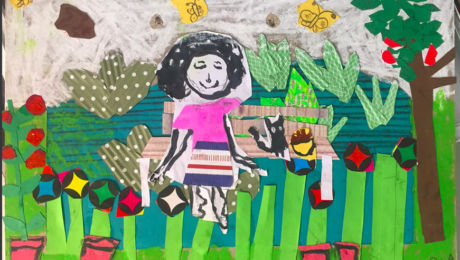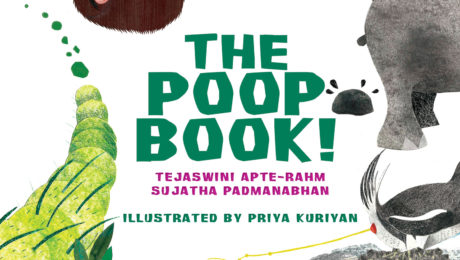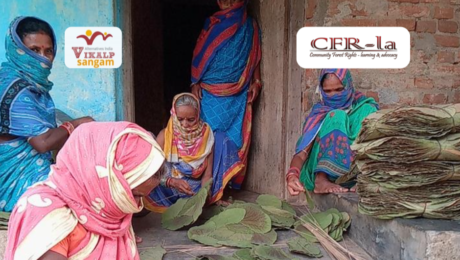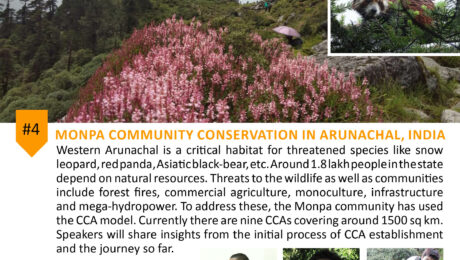Maharashtra Protected Area Update, April 2021, No: 5 (Marathi)
- Published in Announcements
“Voices for Vedanthangal” featured in an article in the Chennai City paper of The New Indian Express
| One of the films commissioned through the Vikalp Sangam process, “Voices for Vedanthangal” was featured in an article in the Chennai City paper of The New Indian Express. For those who may have missed the film, please click here. (This film was part of the Duleep Mathai project where all the activities involved youth or youth-led projects). |
- Published in Announcements
Good news! Two Children’s Books in Big Little Book Art Exhibition
| Our children’s publication “People and Wildlife” was featured in the Ethnicity category of the Diversity Section of the book art exhibition of Parag Initiative’s Big Little Book Award. Also, 6-year old Lola from Mumbai created a beautiful art work based on our publication “The Miracle on Sunderbaag Street” in the Children’s Art Wall of the exhibition. The exhibition includes art by BLBA winner illustrators, budding illustrators and children. It also gives a peep into some picture books addressing diversity that many publishers have been working on for years. 1. Child Art based on The Miracle on Sunderbaag Street: https://www.paragreads.in/parag-nurtures/big-little-bookart-exhibtion-childrens-art-wall/ 2. People and Wildlife figures in the Ethnicity category of the Diversity Section where different categories are mentioned (like Disability, gender etc): https://www.paragreads.in/parag-nurtures/big-little-bookart-exhibtion-diversity-wall/ |
- Published in Announcements
Good news! ‘The Poop Book’ is on the shortlist for the Jarul award.
| We are happy to share that ‘The Poop Book’ written by Tejaswini Apte-Rahm and Sujatha Padmanabhan and illustrated by Priya Kuriyan is on the shortlist for the Jarul award 2021-22. Please click here to read more: https://sites.google.com/asbindia.org/jarulbookaward/2021-22?authuser=0 |
- Published in Announcements
“The Miracle on Sunderbaag Street” has made it to the Parag Honor List 2021
| We are happy to share that “The Miracle on Sunderbaag Street” written by Nandita da Cunha that KV published has made it to the Parag Honor List 2021. Please click here to read more: https://www.paragreads.in/parag-reads/parag-honour-list-books/?publisher=Kalpavriksh |
- Published in Announcements
Maharashtra Protected Area Update, January 2021, No: 4 (Marathi)
- Published in Announcements
CALL FOR SUBMISSIONS: CHILDREN’S BOOKS
| Types of books Illustrated storybooks and non-fiction books for children aged 6 to 14 years Themes We are looking for fiction and non-fiction books on the themes of environment, nature, wildlife (especially lesser known species) and community conservation based in India. How to submit? • We accept manuscripts in English. • Please send all manuscripts by email to Sujatha Padmanabhan [email protected] • Please do not submit previously published work. • Please send complete manuscripts. You may send as many as you like. • We will take up to three months to review your manuscript and get back to you. |
- Published in Announcements
Graphic Novel: Extraordinary Work Of ‘Ordinary’ People, Volume 2
| Extraordinary Work Of ‘Ordinary’ People, Volume 2 now in graphic version. Click here to read. |
- Published in Announcements
‘Khari journeys through Kachchh’ and ‘Po tricks his foe’ – now in Tibetan!
Two of Kalpavriksh children’s books ‘Khari journeys through Kachchh’ and ‘Po tricks his foe’ are now available in Tibetan!
Published by Education Council for Tibetans in Exile, Department of Education, Dharamshala
- Published in Announcements
(MALAYALAM) Extraordinary Work Of ‘Ordinary’ People, Part 2: COMMUNITY FOREST RIGHTS & THE PANDEMIC: GRAM SABHAS LEAD THE WAY!
- Published in Announcements
(HINDI) Extraordinary Work Of ‘Ordinary’ People, Part 2: COMMUNITY FOREST RIGHTS & THE PANDEMIC: GRAM SABHAS LEAD THE WAY!
- Published in Announcements
Kalpavriksh and eCoexist bring you Set of 8 Children’s Books!
| A set of 8 delightful children’s books written by well know environmentalists for kids to learn about Nature and her magic! Books come in a hand made cotton drawstring bag with a Rangoli print on it . |
| Order at : https://www.e-coexist.com/product/childrens-books-set-of-8/ |
- Published in Announcements
Webinar #13: “Self-determination & coping with COVID19 in indigenous Lomerio, Bolivia”
| Global Tapestry of Alternatives and Global Dialogue for Systemic Change present: Dialogue on Alternatives in the Time of Global Crises – a Webinar series Dialogue 13: Self-determination & coping with COVID19 in indigenous Lomerio, Boliviawith Elmar Masay and Maria Chore, Monkoxi leaders, Bolivia Friday 23th October – 1:30 PM (UTC/GMT) 7pm IST Monkoxi leaders from the Indigenous territory of Lomerio, Bolivia, will share experiences dealing with COVID-19. Though the pandemic led to 20 people dying, the Monkoxi were able to control further spread by blocking access in and out of their territories, coordinating with partners the delivery of biomedical equipment, and (esp. important) reviving traditional medicine and community care values and relations. Participatory indigenous research in collaboration with Nur University (Bolivia) and University of East Anglia (UK) is helping systematize this learning, for possible similar out-breaks in future, and to share with other indigenous nations. This builds on several years of process to claim self-determination rights to the territory. Information and registrationDirect access to the session About the presenters Elmar Masay Soquere Elmar Masay Soquere is Chief of the Monkoxi Indigenous Nation of Lomerio, Bolivia, located in the Chiquitano Dry Forest, the last best conserved dry tropical forest in the world. The Monkoxi were the first indigenous nation in Bolivia to self-proclaim themselves autonomous and the first case of forest certification in the country through the Forest Stewardship Council. They are about to become one of the first lowland Indigenous peoples to be recognized as autonomous under the country’s recent autonomy law and 2009 Constitution. From 2000 to 2001 Masay worked as a computer specialist for the Indigenous Center for the Original Peoples of Lomerio (CICOL). Between 2002 and 2009 he served as a technical advisor on the Indigenous Territorial Management Committee in the Native Communal Territory of Monteverde, focusing on sustainable development and natural resource management with the goal of gaining legal autonomy with a territorial base for 128 communities. He also participated in the Indigenous marches for sovereignty and Indigenous rights as well as to advocate for a Constituent Assembly to draft the 2009 Constitution. From 2010 to 2012 Masay provided technical support for the Lomerio Native Communal Territory in the process and legal claim for Indigenous Autonomy on behalf of the 29 communities located in the territory. Between 2013 and 2017 he was elected as chief of economy and production in CICOL. Subsequently, the communities decided to elect him as General Chief of CICOL, which is the maximum authority within the Monkoxi Nation in Lomerio territory. Maria Chore Maria Chore is a woman indigenous leader from Lomerio. As Chief of Autonomy in CICOL, she has played a central role mobilizing and foreseeing the claim for political autonomy before the Bolivian State. She has also been chief of Gender issues in CICOL and has worked as indigenous researcher in various projects related to the reconstruction of the Monkox indigenous identity. Our past webinar sessions videos are available in this link. |
| Global Tapestry of Alternatives[email protected]To subscribe and get our updates, visit this link |
- Published in Announcements
Launching an interactive map on Conservation Conflicts in India
On the occasion of #WildlifeWeek the #EJAtlasteam and Kalpavriksh are launching an interactive map on Conservation Conflicts in India, which reveals the impacts of this fortress-like conservation model in India. This new map documents the violations of Wildlife laws in Protected Areas and shows the struggles of local and Indigenous communities opposing policies that exclude them from the current management of natural resources. The map reveals lack of regard for the self-determination of the communities by the government authorities.#ConflictsPAIndia
- Published in Announcements
Webinar: Community Conserved Areas in South Asia #4: Monpa Community Conservation in Arunachal Pradesh, India
Dear All,
As part of the webinar series on Community Conserved Areas organised by the ICCA South Asia Regional Coordination Committee, the next webinar will be on the Monpa communities in Arunachal Pradesh, India on 6th October at 5pm.
To register: https://zoom.us/webinar/register/WN_Kt65RLgzQkWPXd4iTDxPdA
To view on Youtube live: https://www.youtube.com/c/iccaconsortium/live
About the CCA
The Indian state of Arunachal Pradesh is located within the Himalayas Biodiversity Hotspot. Large parts of the state’s forested area (>60% accounting 3.1 million ha) are under traditional ownership of tribal communities. These forests are managed by clans, traditional village institutions and individuals. Within the West Kameng and Tawang districts of Arunachal Pradesh, the area under community custodianship is even higher. In these two districts, more than 80% of forests are de-facto under the jurisdiction of the local communities and administered by their customary laws.
The biological richness of the forests of Arunachal Pradesh are amongst the highest in the Himalayan region. The Western Arunachal Landscape, is endowed with luxuriant forests and a great diversity of plant and animal species, many of which are endemic to the Eastern Himalayas. The region is also a critical habitat for several species on the IUCN Red List such as the snow leopard, red panda, Asiatic black-bear, clouded leopard, golden cat, serow, and black-necked crane. Most of these threatened species are facing threats from habitat degradation and fragmentation, emerging developmental projects, hunting and other anthropogenic pressures.
Approximately 0.18 million people (with ~80% rural population) depend on natural resources in Arunachal Pradesh. Mostly, a traditional agro-pastoral system is followed using available natural resources. The community manages oak (Quercusgriffithii) forests around their farmland to collect fallen leaves for the purpose of mulching, and also practice mixed cropping with a combination of legumes that helps maintain soil fertility. However, the traditional dependency and relationship between the local communities and natural resources is eroding; threatened by an increase in commercial demand and a breakdown of traditional institutional mechanisms. The forests of Arunachal Pradesh face several other threats i.e. forest fires, clearing of forests for commercial agriculture, monoculture plantations, linear infrastructure and mega-hydropower development.
To address some of these challenges, the local Monpa communities of the region have mobilized themselves around the Community Conserved Area (CCA) model. The work to establish CCA in the forest areas under their jurisdiction was initiated nearly a decade and half ago and currently there are nine CCAs covering around 1500 sq. km of forest. It all began in Thembang village in West Kameng district when the local community setting up the Thembang Bapu CCA on 30 km2 of forests under their custodianship. Later, this was expanded to cover 635 km2 encompassing dense forests with snow-capped mountains and high-altitude lakes that provide a secure habitat for threatened species including the red panda and snow leopard. In order to complement and strengthen the forest conservation initiative, community-based tourism (CBT) was introduced in 2009. The CCA Management Committee in Thembang has greatly matured and operates independently. The Community Based Organization was also with a little support from WWF India able to manage and implement a project from the Department of Science and Technology, Government of India on marketing their crop produce. Community leaders and local team members from WWF-India will share insights and learning from the initial processes of CCA establishment and the journey so far.
Speakers:
Jam Tsering, Zilla Parishad Member & Secretary, Thembang Bapu Community Conserved Area.
Pema Wange Sr. Project Officer, WWF-India & Member, Thembang Bapu Community Conserved Area.
Lham Tsering Field Officer, WWF-India & Member, PangchenLakhar Community Conserved Area.
Kamal Medhi Landscape Coordinator, WAL, WWF-India.
Pijush K Dutta Lead, Community Engagement, WWF-India
To view the previous webinars:
1. Fishing Communities of Loktak Lake, Manipur by Salam Rajesh
2. Wetland Conservation in Vidharba, Maharashtra by Manish Rajankar(BNVSAM) and Shalu Kolhe
3. Van Panchayats in Uttarakhand by Malika Virdi, Rekha Rautela and Beena Nitwal
For any query or to sign up to the CCA South Asia elist, please write to [email protected]
Regards
ICCA South Regional Coordination Committee
- Published in Announcements














